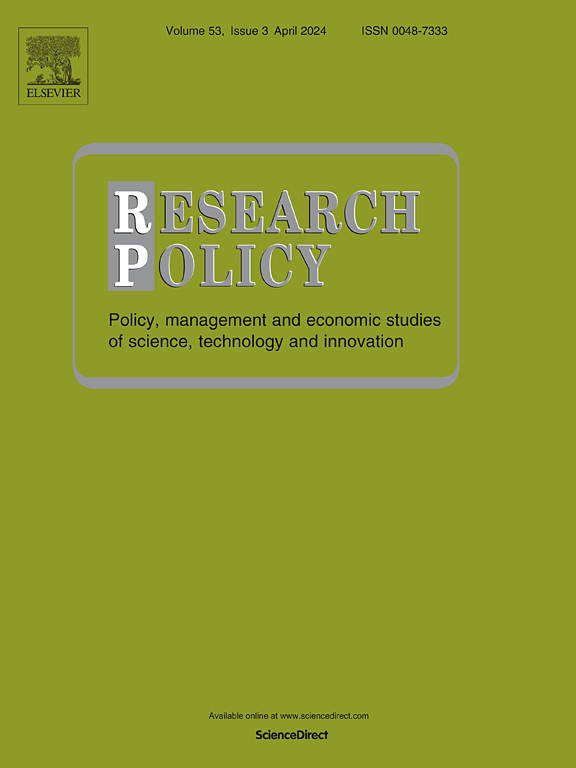Technological change, incumbent dominance, and knowledge base evolution in multi-technology industries: A patent analysis of the global automotive sector
IF 8
1区 管理学
Q1 MANAGEMENT
引用次数: 0
Abstract
Traditional models of creative destruction posit that established firms often stick to their dominant technology, exhibiting resistance to change even when new technologies emerge. However, recent perspectives challenge this view, suggesting that incumbents can adapt and innovate in response to technological disruption. This paper contributes to this debate by asking, “What factors influence incumbent firms' sustained market dominance amidst technological change?” We address this question by focusing on the automotive industry — a multi-technology sector characterised by products integrating diverse technological components with varying rates of change, and where incumbents serve a central role as “systems integrators.” By analysing the patent portfolios of the top 25 automotive Original Equipment Manufacturers (OEMs) over a 30-year period (1990–2019), we provide valuable insights into innovation patterns within the automotive sector, specifically concerning the emergence of new technological fields and shifts in industry composition. Our analysis reveals that the structure and evolution of the industry's knowledge base inherently protect incumbents from new entrants, thereby explaining their dominance. This theoretical perspective, coupled with the observed transformation of the automotive industry, highlights the need to investigate whether incumbents' primacy in technological development alone could prevent a future industry shakeout in the absence of relevant investments in product and process innovation. The paper further argues that incumbent inertia amidst technological discontinuities presents a challenge for policymakers, emphasizing the potential need for regulatory intervention to accelerate the transition towards a greener automotive industry.
多技术产业中的技术变革、在位者主导地位和知识库演变:全球汽车行业的专利分析
传统的创造性破坏模式认为,老牌企业往往坚持自己的主导技术,即使新技术出现,也表现出对变革的抵制。然而,最近的观点挑战了这一观点,认为现有企业可以适应和创新以应对技术颠覆。本文通过提出“在技术变革中,什么因素影响在位企业持续的市场支配地位?”我们通过关注汽车行业来解决这个问题——汽车行业是一个多技术行业,其特点是产品集成了不同技术组件,具有不同的变化率,现有企业作为“系统集成商”发挥着核心作用。通过分析排名前25位的汽车原始设备制造商(oem)在30年期间(1990-2019年)的专利组合,我们为汽车行业的创新模式提供了有价值的见解,特别是关于新技术领域的出现和行业构成的转变。我们的分析表明,行业知识库的结构和演变本质上保护了现有企业免受新进入者的侵害,从而解释了它们的主导地位。这一理论视角,再加上观察到的汽车行业转型,突显出有必要调查现有企业在技术开发方面的主导地位,是否能够在缺乏产品和工艺创新相关投资的情况下,防止未来的行业洗牙。本文进一步认为,技术不连续性中的现有惯性对政策制定者提出了挑战,强调了监管干预的潜在需求,以加速向绿色汽车工业的过渡。
本文章由计算机程序翻译,如有差异,请以英文原文为准。
求助全文
约1分钟内获得全文
求助全文
来源期刊

Research Policy
MANAGEMENT-
CiteScore
12.80
自引率
6.90%
发文量
182
期刊介绍:
Research Policy (RP) articles explore the interaction between innovation, technology, or research, and economic, social, political, and organizational processes, both empirically and theoretically. All RP papers are expected to provide insights with implications for policy or management.
Research Policy (RP) is a multidisciplinary journal focused on analyzing, understanding, and effectively addressing the challenges posed by innovation, technology, R&D, and science. This includes activities related to knowledge creation, diffusion, acquisition, and exploitation in the form of new or improved products, processes, or services, across economic, policy, management, organizational, and environmental dimensions.
 求助内容:
求助内容: 应助结果提醒方式:
应助结果提醒方式:


